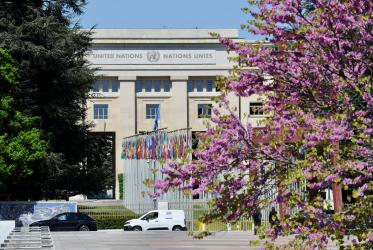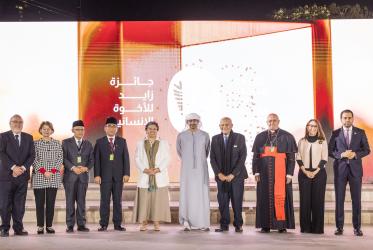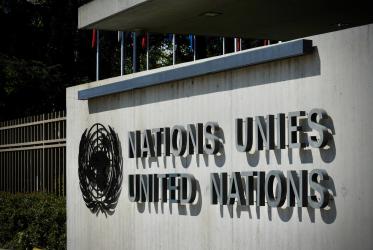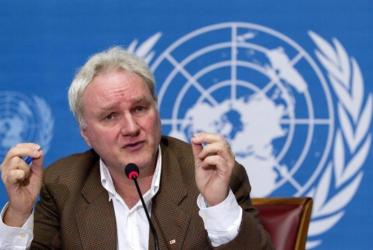Statement by the WCC Executive Committee, 13-16 September, 2005
The Executive Committee of the World Council of Churches, meeting in Geneva,
September 13-16, 2005, speaks out on small arms and light weapons to affirm
God's vision of life in peace and fullness. We commend to citizens and authorities
the establishment of good order in a culture of peace. We stand in solidarity
with all who suffer the consequences of gun violence or live at risk.
Churches of the WCC have long pledged to live without resort to arms (Nairobi
Assembly, 1975). Human security "rests in God [and] in mutual respect among
the children of God" (Consultation on Militarism and Disarmament, Geneva,
1989). The WCC has repeatedly applied policies of disarmament and reconciliation
to public life. WCC churches have designated the first ten years of this century
as the Decade to Overcome Violence, a goal inseparable from the control of
small arms and light weapons.
Among the many biblical admonitions for peace, one verse from the prophet Isaiah
inspires churches on every continent. Its call to arbitrate, reform and begin anew
is echoed in today's disarmament debates:
"He shall judge between the nations, and shall arbitrate for many peoples; they shall
beat their swords into ploughshares, and their spears into pruning hooks; nation shall
not lift up sword against nation, neither shall they learn war any more." (Isaiah
2:4)
In recent years churches have become leaders for peace in certain crisis zones, with
women's groups resolving conflicts, pastors restoring shattered lives, peace education
rising on the parish agenda, and public demonstrations supporting the rule
of law. Faithful leaders and parishioners are exercising their unique potential to
make the proliferation and misuse of small arms/light weapons a matter for public
awareness, concern and remedial action.
Meanwhile church and other humanitarian and development agencies are finding
ways to protect beneficiaries, aid workers and programmes from the threat of
small arms. Programmes to disarm, demobilize and reintegrate ex-combatants
are being refined over time, with some of the churches involved also stressing the
need to work reconciliation into the same process.
Churches and church-related organizations in East, West and Southern Africa and
in Latin America, play key roles in community, national and regional projects to
break the chain of supply and demand for weapons. Churches and church-related
development organizations in the global North are strong supporters of such
initiatives in the South, including the pioneering civil society and government
scheme for regional arms control, the Nairobi Protocol. In Northern countries
with significant small arms problems of their own, WCC member churches figure
prominently among the advocates for corrective action.
In nations where the growing problem of firearms proliferation and misuse becomes
the focus of a thorough public debate, new limits can be imposed on weapons
possession and use. Experience in country after country shows that the road to
stricter, more universal and more enforceable controls is arduous, but that progress
is well within current capacities for governmental rule-setting, corporate responsibility,
and public education.
At the international level today states are building a worldwide regulatory framework
for the control of small arms and light weapons. The first pillar was the
United Nations Programme of Action in this field in 2001. The UN instruments
currently under discussion must assure implementation of measures already agreed
and begin to address the broad challenges to human security that remain. States
are not alone in this endeavour. Leading up to the UN Review Conference on the
Illicit Trade in Small Arms and Light Weapons in All Its Aspects in 2006, new armscontrol
partnerships between civil society groups and public authorities offer new
models for success. A world of 640 million firearms that are largely uncontrolled
requires this and much more.
Small arms and light weapons are weapons designed for use by one or two people.
They range from pistols and sub-machine guns to rocket-propelled grenades and
man-portable anti-aircraft missiles. Ammunition and landmines are part of the general
category. Portability, low cost, ease of use and minimal maintenance of these
weapons increase individual use, private ownership and black market potential.
Small arms and light weapons are used in the vast majority of the world's deaths
by violence, taking about 1,000 lives each day. Small arms are used in some
350,000 suicide, homicide and conflict deaths each year. Many more deaths and
injuries are caused indirectly when small arms accumulate and spread in unstable
circumstances. Their presence fuels conflict, exacerbates abuses of human
rights, criminal law and international humanitarian law, and creates obstacles to
development. Weapons dispersed in war also remain available for years to disrupt
peace, or derail it.
Most of those who die from firearms are people in the prime of life.
The risk factors associated with firearms apply within all countries, rich and poor.
Small arms are especially dangerous: wherever masculinity is associated with violence;
wherever disputes are settled by violence; where law enforcement is ineffective
or gangs hold sway; where poverty and socio-economic inequality are high.
Mere access to firearms is itself a major risk factor for violence - in suicides and
in family and civil disputes.
Men perpetrate the most armed violence and are first among gunshot victims.
Women experience a greater range of secondary consequences as well as direct
injury and death. Women in affected areas deal daily with the threats and consequences
of small arms violence. In conflict zones, their vulnerability tends to
increase as societal constraints on men weaken. Damage to livelihoods, nutrition,
health and education places additional burdens on women, as does the absence or
loss of male family members. Women also use guns in combat and fill support
roles for armed forces and armed groups.
The fate of children in conflict is increasingly shaped by small arms. Added to
the direct toll in child casualties are intense fear, the loss of parents, providers and
friends, uprooting, abduction, lost education, healthcare and aid, plus long-term
traumas. Small arms technology makes it possible for children to carry and use
adult weapons. An eight-year-old can be taught to fire an assault rifle.
All ages endure violence in the media, an increasingly important factor in the
complex phenomenon of violence today. Incessant, unrealistic, glorified - it conditions
childhood behaviour, influences cognitive development and shapes perceptions
of reality throughout life. Media violence influences violent behaviour
in the same way that advertisements influence consumer behaviour, with repetition,
temptation and personal gratification. Media violence puts violent options
on the agenda of society on a scale that would be difficult to replicate by any other
legal means.
Small arms manufacturing takes place in more countries than any other sector of
the global arms industry. The production and sale of small arms is dominated by
the world's leading economies, but more and more developing countries have
become involved since the end of the Cold War. Supplied mostly from that licit
trade, the illicit trade in small arms is also widespread, an exercise in underground
globalisation. Weapons are a commodity - along with drugs, diamonds, timber
and even human beings - traded on the black market to illegal groups. Arms brokers
use the existing infrastructure of the world economy to circumvent national
and international arms controls, enabled at times by inept or corrupt officials.
Approximately eight million firearms are manufactured each year. Some 300,000
guns are destroyed through micro-disarmament projects. The world community
has the potential to reverse this trend. Change will come as political and corporate
authorities, and individuals and groups at all levels, take greater responsibility
for the geopolitical economy in small arms.
Recommendations for Action
The Executive Committee calls on churches to take responsibility in the following
areas related to the control of small arms and light weapons:
Promote and support legislation and programmes that enhance community
safety and well-being, address gun violence, and reduce related human suffering.
Work with civil society and governmental bodies to enhance controls over the
production, trade, possession and use of small arms, light weapons and ammunition;
and to judge the effectiveness of such efforts by reductions in the numbers
of victims.
Make multilateral and interdisciplinary collaboration an integral part of church
policies and actions on gun violence.
Build networks within and between churches to advocate for change, including
the adoption of an effective international Arms Trade Treaty.
Share local and national information and best practices with church counterparts
and others internationally.
Commit more fully to Christian teaching about peace and disarmament within
and beyond the church and to promoting the peaceful resolution of conflict
within society and between nations.
Responsibility for Use
Exercise the unique potential of the church to curb demand for small arms and
light weapons, especially by changing public attitudes, shaping community
values and becoming a public voice against gun violence. Recommended actions
include education of children about firearms, parish collection and destruction
of weapons, mentoring of ex-combatants and at-risk youth, dialogue with progun
groups, and political support for local, national and international arms
control measures.
Provide pastoral care and assistance for gunshot survivors and carry out public
education and advocacy work about gun violence with and for survivors.
Provide early warnings of conflict if small arms are introduced or increase in
areas the church serves or monitors.
The Executive Committee calls on governments and civil society groups, as well
as churches, to take responsibility for the possession and use of small arms as follows:
Support and strengthen programmes that enlist broad community participation
in reducing gun violence and that address the respective roles and responsibilities
of women and men in overcoming gun violence.
Include activities to prevent gun violence in public health, public security,
human rights and development programmes.
Promote and apply international human rights and humanitarian law as the
standard for judging the use and misuse of firearms by military and armed
groups.
Implement, monitor and evaluate international standards for post-conflict disarmament
and demobilization, for the long-term reintegration of ex-combatants
in society, and for reconciliation within affected communities.
Include small arms controls in responsive measures where vulnerable populations
face extraordinary risks, as part of the international norm known as the
Responsibility to Protect'.
Ensure that former child soldiers are reintegrated into communities, schools
and homes. Advocate for a binding international convention to prohibit children
from serving in any capacity with any armed force. Ban arms sales to governments
and groups that use children as soldiers.
The Executive Committee calls on businesses, governments, civil society groups
and churches to take responsibility for violence in media:
Address, as a matter of profound relevance for the long-term reduction of violence,
the portrayal and dissemination of violence in media and electronic
games. Take remedial action against the delivery and consumption of violent
media content in homes and communities.
Set community-based standards to limit violent content in electronic and broadcast
media and to support a workable rating system for games and media programmes.
Boycott or ban games with excessive or gratuitous violence. Promote
and encourage non-violent games, films and programmes.
Controlling Supply and Suppliers
The Executive Committee calls on governments and inter-governmental organizations
to control the supply of small arms and regulate weapons suppliers:
Provide for implementation of existing small arms/light weapons controls at
the 2006 United Nations Review Conference and, there and in future, add new
and binding agreements that prohibit transfer to non-state actors, govern the
licensed trade in small arms, limit civilian possession, and control arms already
present in communities.
Negotiate a comprehensive and legally-binding treaty to make arms transfers
lawful, limited and licensed, to stop transfers to the black market, and to make
suppliers partially liable for human rights violations committed with their
products. Ensure that any such Arms Trade Treaty sets clear criteria for compliance
and verification. Adopt regional codes of conduct for governments
regarding the legal trade in arms.
Adopt and implement the international agreement of 2005 on marking and
tracing of small arms and light weapons.
Prohibit the civilian possession and use of assault rifles and other excessively
dangerous gun types and ammunition.
Given appropriate licensing and storage provisions, define legal possession and
use of small arms based on types appropriate for military, police and security
personnel and types appropriate for licensed hunters, target shooters and weapons
collectors.
Enlist the small arms industry in aligning the design, manufacture, advertising,
sales and brokering of lethal weapons with the usage of those weapons that
is allowed under international and national law.
Levy taxes on small arms sales and exports in order to offset costs incurred by
gun violence in society, including the cost of training in the non-violent resolution
of conflicts.
Ensuring Accountability
The Executive Committee calls on governments, inter-governmental organizations
and businesses, in partnership with civil society to:
Clarify commitments and maximize transparency in corporate and government
arms affairs through the use of legislation, investigation, and lobbying and
public disclosure. Define and achieve specific accountabilities throughout the
product cycle - in design, manufacture, sales, brokering, trafficking, acquisition,
storage, use and demolition.
Require full disclosure of small arms and light weapons exports by all armsexporting
nations; sanction states that are malfeasant.
Integrate United Nations standards for law enforcement and security usage of
firearms into national legislation; establish civil society mechanisms to evaluate
national compliance with those standards.
Provide political, financial, technical and spiritual support for the implementation
of policies recommended here.




